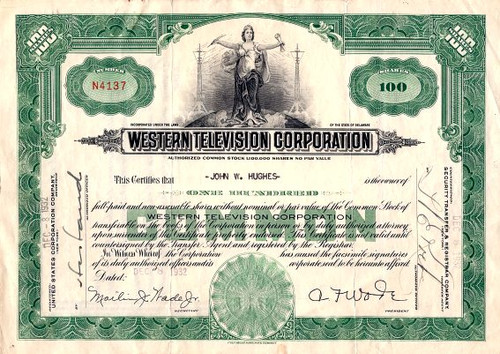Beautiful certificate from the Picture Transmission Corporation issued in 1928. This historic document was printed by the Hamilton Banknote Company and has an ornate border around it with the company name centered on the top. This item has the signatures of the Company's President, Loj Harley and Assistant Treasurer, E. L. Swartz and is over 81 years old. 
The company owned the following early Television Patent: # 1,680,666 Oct. 30, 1928. M. FERREE ET AL METHOD OP TRANSMITTING PICTURES AND SENDING PLATE THEREFOR Filed Jan. 28, 1925 2 Sheets-Sheet I M. FERREE ET AL 1,689,666 METHOD OP TRANSMITTING PICTURES AND SENDING PLATE THEREFOR Filed Jan. 28, 1925 2 Sheets-Sheet 2 Patented Oct. 30, 1928. 1,689,666 UNITED STATES PATENT OFFICE. MARVIN FERREE, OF NEW YORK, N. Y., AND JOSEPH WISSMAR, OF CLEVELAND, OHIO, ASSIGNORS, BY DIRECT AND MESNE ASSIGNMENTS, TO PICTURE TRANSMISSION CORPORATION, OF NEW YORK, N. Y., A CORPORATION OF DEL AWAKE. METHOD OF TRANSMITTING PICTURES AND SENDING PLATE THEREFOR. Application filed January 28, 1925. Serial No. 5,258. This invention relates to a new and improved method of transmitting pictures by means of electrical pulses and for a new and improved sending plate adapted to be 6 used in connection with said method. One of the objects of this invention is to provide a method of transmitting pictures by means of a series of electric pulses whereby those portions of the picture which cor- 10 respond to the intermediate or gray portions thereof shall be sufficiently emphasized so that the reproduced picture will properly correspond to the original picture. Another object of this invention is to de- 18 vise a method of transmitting pictures by means of a series of electric pulses whereby the electric pulses, or the intervals between electric pulses will be extremely long when the gray or intermediate portions of the 20 picture are being transmitted. _ - Another object of this invention is to devise a new and improved broken tone transmitting plate of the picture to be transmitted in which the picture consists of a series of 25 separated and parallel lines of varying thickness, and in which said plate will be iree from these parallel lines in those portions of said plate corresponding to the intermediate or gray portions of the picture 30 to be reproduced. Other objects of this invention will be set forth in the following description and drawings, it being understood that the above general statement of the objects of this in- 35 vention is intended, not to limit the invention, but to generally explain the purposes thereof. : Fig. 1 shows a transmitting plate of a picture to be reproduced, made according to 40 the old method. Fig. 2 shows a plate made according to this new and improved method and to be used in transmitting pictures according to the new and improved method. 46 It has been previously suggested to use a broken tone plate of the picture to be transmitted, in order to transmit the said picture by means of a series of electric pulses and this, for example is shown in U. £>. Pat- 50 ent No. 577,373, issued on .Feb. 16, 1897, to Foah S. Amstutz, and in U. S. Patent No. 1,026,297, issued on May 14, 1912, to Thgnias Thorne Baker. In the methods previously used, the half tone plates employed for controlling the series of electric 65 pulses were made as shown in Fig. 1 and by the ordinary method employed in making half tones so that the entire picture was broken up into separated areas save where the natural composition or color effect of 80 the picture to be transmitted caused the transmitting plate to have solid white or black areas. If, however, the composition of the picture to be transmitted was such that it was composed throughout of inter- 65 mediate or gray tones of varying intensity, then the entire transmitting plate was broken up as illustrated in Fig.-1.1 According to .this invention, the transmitting plate, which is^pref erably a negative; 70 is produeced by being exposed in such manner that the lighter tones of the picture and particularly the background thereof, are accentuated so that corresponding solid dark masses are produced in the same negative, as 76 illustrated in Fig. .2. ' The picture to b!e reproduced is first placed in front of an ordinary camera so that a negative can be made thereof. This negative is made upon an ordinary trans- 80 parent glass plate, either wet or dry. Before the negative impression is made, a transparent grating having a series of parallel opaque lines is placed in the camera before the negative, so that the negative image 85 consists of a series of parallel opaque lines of varying width, and the continuous tone of the picture to be transmitted is thus duplicated in what may be called broken tone. The spacing of the^opque lines may vary, 90 and without being limited to any particular spacing, it has been found that a grating having sixty-five (65) lines to the. inch is satisfactory for reproducing ordinary photographs. The width of the said opaque 95 lines may be equal to the distances between them, although various types of grating may be employed. By using gratings having parallel lines, a superior effect is produced for this particular purpose, in contrast with 100 gratings having lines crossing each other, because by using a single grating having parallel lines, the points of light in the picture to be transmitted are spread out only in the vertical direction instead of being spread l°6 out both in the vertical and in the horizontal direction. It is preferred to ,have the opaque lines of the grating held horizontally.....









